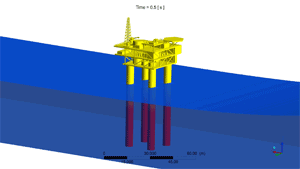Marine and Offshore CFD Simulation
March 28, 2014
 Dear Desktop Engineering Reader:
Dear Desktop Engineering Reader:
I know in my gut, and I have quite the gut, that offshore oilrigs are engineered to withstand all sorts of horrid weather. Lots of finite element, CFD (computational fluid dynamics) analyses and specialized hydrodynamics assessment software are among the tools of the trade. Still, I’m a fish in shallow water when it comes to the depths of analyses for marine and offshore applications. So that’s also why I really enjoyed today’s Check it Out content from ANSYS. If you’re in the marine and offshore CFD simulation business, today’s Check it Out seems like a must read. If you toil in some other domain or use CFD for something entirely different, this is terrifically fascinating engineering stuff that you’ll enjoy.
The idea behind the “Marine and Offshore CFD Simulation – Hydrodynamics and Wave Impact Analysis” tech tip web page is simple enough: Flow solvers like ANSYS Aqwa hydrodynamics assessment software are commonly used to investigate wave loading and buoyancy dynamics from a global perspective. But engineers designing oil platforms, ships and other marine structures, also use a lot of 3D CFD to model and predict things like ship drag and dynamic motion in waves, wave loading on offshore platforms and the behavior of water when tons of it collect on a ship’s deck because of big, storm-driven waves. The web page explains the tools ANSYS offers for fluid dynamics and marine simulation and how you can use them.
In a nutshell, we’re talking about a suite of analysis software that can handle hydrodynamics and wave impact simulations for studying a range of waves, such as shallow-water waves, nonlinear oceanic waves and even tsunamis, and their effects on anchored structures. You can simulate how waves interact with offshore platforms, ships and other marine structures using software tools like ANSYS Fluent for high-end, detailed flow modeling and ANSYS Mechanical for structural finite element analyses, including linear, nonlinear and dynamic studies. You can connect all of your CFD and FEA simulation results to ANSYS Aqwa and then predict the behavior of moored or connected systems at random sea states.
At the heart of the page is a 6-minute video on hydrodynamics and wave loading that show you how this all works. The scenario uses ANSYS Fluent to predict hydrodynamic forces and green water phenomena of an ocean wave bashing into an offshore platform. (The term “green water” describes what happens when a lot of water accumulates on a ship’s deck because of huge storm waves.) The column and deck reaction force of the wave as a function of time are what we’re after. We’re also looking to see if the wave will really hit the decks. This narrated demo takes you step-by-step through a multiphase volume of fluid model analysis.
Supplementary data on the page includes a pair of articles. The first is a case study on how a marine engineering company uses ANSYS Fluent for up-front simulation when designing ships. Their goal is to keep structural vibrations low so as to make a vessel more comfortable for the crew and last longer. The second article is also a case study. It looks at how Rolls-Royce uses simulation for propeller design with an eye toward reducing marine fuel consumption.
Also available are a webinar on multiphase modeling with ANSYS CFD and a presentation on ANSYS CFD for naval applications. The latter, a 23-page PDF, provides more details of the ANSYS Aqwa. Two short video testimonials and a couple of brochures round out the data you can access.
“Marine and Offshore CFD Simulation – Hydrodynamics and Wave Impact Analysis” is something like the ninth ANSYS Tech Tip in this series. Once again, the company has taken the time to create a full resource for users and potential users as well as a stimulating multimedia demonstration for everyone. Hit the today’s Check it Out and learn and enjoy. Well done.
Thanks, Pal. – Lockwood
Anthony J. Lockwood
Editor at Large, Desktop Engineering
Go to the ANSYS Tech Tip “Marine and Offshore CFD Simulation – Hydrodynamics and Wave Impact Analysis.”
Subscribe to our FREE magazine, FREE email newsletters or both!
About the Author
Anthony J. Lockwood is Digital Engineering’s founding editor. He is now retired. Contact him via [email protected].
Follow DERelated Topics







